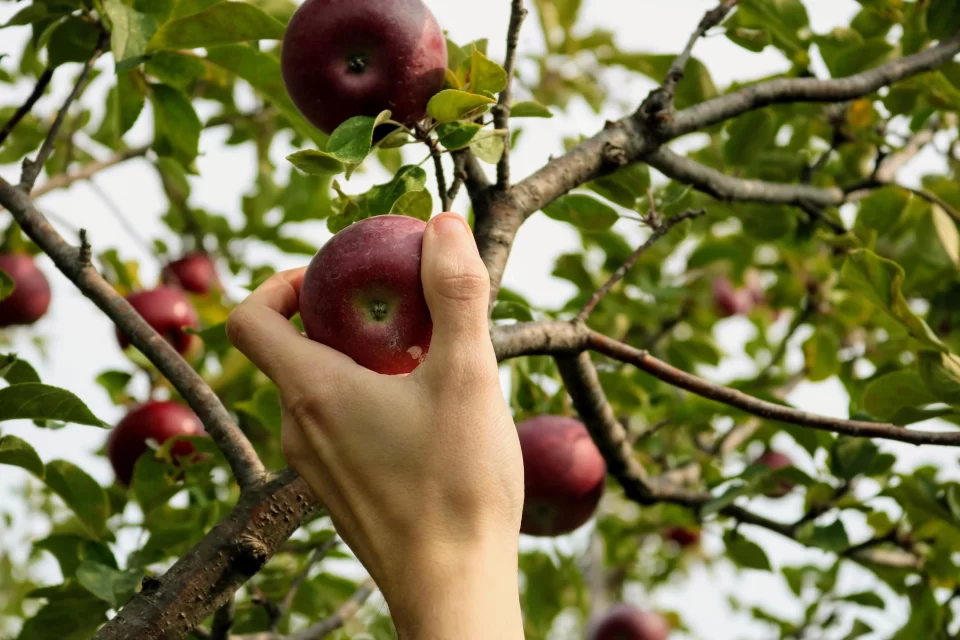The success of your apple tree starts with understanding your local climate and soil conditions. Britain’s climate varies from the cooler, wetter regions of Scotland to the milder, drier areas of southern England. It’s essential to select apple varieties that are well-suited to your specific region.
Climate Considerations:
- Chill Hours: Apple trees require a certain number of chill hours (hours below 7°C) to break dormancy and produce fruit. Varieties that need fewer chill hours are more suited to milder regions.
- Frost Resistance: Late frosts can damage blossoms and affect fruit set. Choose frost-resistant varieties if you live in an area prone to late frosts.
- Soil Type:
- pH Levels: Apple trees grow well in neutral to somewhat acidic soil (pH 6.0–7.0). Test the soil and make any needed adjustments.
- Drainage: Well-drained soil is crucial for apple trees. Avoid waterlogged areas, as excessive moisture can lead to root diseases.
- Soil Composition: Loamy soils rich in organic matter are ideal. Sandy soils can be improved with compost, while clay soils may require gypsum to enhance drainage.
Selecting the Right Apple Varieties
Apple trees for sale varieties differ in taste, texture, and harvest times according to ChrisBowers. Choosing the right variety depends on your personal preferences and intended use, whether for fresh eating, cooking, or cider making.
- Taste Preferences:
- Sweet Apples: Ideal for fresh eating, popular sweet varieties offer a juicy, crisp bite.
- Tart Apples: Perfect for cooking and baking, tart apples hold their shape and flavor when heated.
- Balanced Flavors: Some varieties provide a balance of sweetness and acidity, making them versatile for both eating and cooking.
- Pollination Groups:
- Self-Fertile vs. Cross-Pollination: While some apple trees are self-fertile, most require cross-pollination from another variety to set fruit. Planting multiple compatible varieties will ensure better fruit production.
- Blooming Periods: Select varieties that bloom at the same time to facilitate cross-pollination. Pollination groups are typically categorized from 1 to 4, with group 1 blooming earliest and group 4 latest.
- Harvest Times:
- Early Season: These varieties ripen in late summer and are typically ready by August or early September.
- Mid-Season: These apples are harvested in late September to early October.
- Late Season: Late-ripening varieties can be picked in October or even early November, providing fresh fruit well into autumn.
Rootstocks and Tree Size
The choice of rootstock affects the size, vigor, and disease resistance of your apple tree. There are several rootstocks commonly used in Britain, each with its own characteristics.
- Dwarf Rootstocks:
These produce smaller trees, ideal for small gardens or containers. They typically require staking for support.
Popular dwarf rootstocks include M27 and M9.
- Semi-Dwarf Rootstocks:
Semi-dwarf trees are a good compromise, offering moderate size with good fruit production. They are suitable for most home gardens.
Common semi-dwarf rootstocks are M26 and MM106.
- Vigorous Rootstocks:
These rootstocks produce large trees, suitable for orchards or large spaces. They require more maintenance and space.
Examples include MM111 and M25.
Planting Your Apple Tree
Proper planting techniques are crucial for the establishment and growth of your apple tree. Here are the steps to ensure successful planting:
- Site Selection:
Choose a sunny location with at least 6-8 hours of direct sunlight daily. Good air circulation helps reduce disease risk.
Ensure the site is sheltered from strong winds.
- Planting Hole:
Dig a hole twice as wide and as deep as the root ball. This gives the roots room to spread and establish.
Mix compost or well-rotted manure into the soil to improve fertility.
- Planting Depth:
Place the tree in the hole, ensuring the graft union (the bulge above the rootstock) is above soil level to prevent rot.
To eliminate air spaces, backfill the hole with dirt, firming it slightly around the roots as you go.
- Watering:
Water the tree thoroughly after planting. Keep the soil consistently moist but not waterlogged, especially during the first growing season.
Mulching around the base of the tree helps retain moisture and suppress weeds.
Pruning and Training
Pruning and training your apple tree are essential for its health, shape, and productivity. These practices help to control the size of the tree, encourage the growth of fruiting wood, and improve air circulation.
- Initial Pruning:
In the first year, prune the tree to establish a strong framework. Remove any damaged or weak branches.
Aim for a central leader (one main vertical stem) with evenly spaced lateral branches.
- Annual Pruning:
Prune during the dormant season (late winter to early spring) before new growth starts.
Remove any crossing or inward-growing branches to maintain an open canopy.
Cut back overly vigorous growth to encourage the development of fruiting spurs.
- Summer Pruning:
In summer, prune to control excessive growth and shape the tree.
Remove water sprouts (vigorous, vertical shoots) and any suckers growing from the base.
- Training Systems:
There are various training systems for apple trees, including open-centre, central leader, and espalier. Choose a system that suits your space and aesthetic preferences.
Espalier Training: This method is ideal for small spaces or decorative purposes. It involves training the tree to grow flat against a wall or fence.
Pest and Disease Management
Apple trees are susceptible to various pests and diseases. Implementing proactive management strategies is essential to keep your trees healthy and productive.
- Common Pests:
Aphids: These small insects can cause distorted leaves and sap the tree’s vigor. Use insecticidal soap or encourage natural predators like ladybirds.
Codling Moth: The larvae of this moth burrow into apples, causing damage. Use pheromone traps and apply insecticides if necessary.
Apple Sawfly: This pest lays eggs in the blossoms, leading to deformed fruit. Remove affected fruitlets and use traps to monitor populations.
- Common Diseases:
Apple Scab: This fungal disease causes dark, scabby lesions on leaves and fruit. Select resistant varieties and apply fungicides if needed.
Powdery Mildew: This disease appears as a white, powdery coating on leaves and shoots. Prune affected parts and ensure good air circulation.
Fire Blight: This bacterial disease causes wilting and blackening of blossoms and shoots. Remove infected branches and disinfect pruning tools.
- Integrated Pest Management (IPM):
IPM combines cultural, biological, and chemical methods to manage pests and diseases. Encourage beneficial insects, practice good sanitation, and use chemical controls as a last resort.
Regularly inspect your trees for signs of pests and diseases, and take action promptly to prevent severe infestations.
Fertilization and Care
Proper fertilization and care are essential to maintain the health and productivity of your apple trees. Follow these guidelines for optimal growth:
- Fertilization:
Apply a balanced fertilizer in early spring before new growth begins. Use a fertilizer with equal parts nitrogen, phosphorus, and potassium (e.g., 10-10-10).
Don’t overfertilize; too much nitrogen might promote lush foliage development at the price of flowering.
Organic options such as compost, well-rotted manure, and fish emulsion are excellent alternatives to synthetic fertilizers.
- Watering:
Consistent watering is crucial, especially during dry spells. Aim for deep watering to encourage deep root growth.
Mulch around the base of the tree helps retain moisture and reduce evaporation.
- Weed Control:
Weeds compete with apple trees for nutrients and water. Keep the area around the base of the tree weed-free.
Mulching helps suppress weeds and provides additional organic matter as it decomposes.
- Thinning:
Thinning the fruit helps improve the size and quality of the remaining apples. In late spring or early summer, remove excess fruit so that the remaining apples are spaced about 10-15 cm apart.
Thinning reduces the risk of branch breakage due to heavy fruit loads and helps prevent biennial bearing (alternating years of heavy and light crops).
Harvesting and Storing Apples
Harvesting apples at the right time ensures the best flavor and storage quality. Different apple varieties have different ripening periods, and knowing when to pick them is key.
- Determining Ripeness:
Check the color: Mature apples develop their characteristic color, and the background color changes from green to yellow.
Taste test: Sample a few apples to check for sweetness and texture.
Ease of picking: Ripe apples should come off the tree easily with a gentle twist.
- Harvesting Techniques:
Handle apples gently to avoid bruising. Use both hands to twist and lift the fruit from the branch.
Harvest in the morning when temperatures are cooler to reduce stress on the fruit.
- Storing Apples:
Store apples in a cool, dark place with good air circulation. Ideal storage temperatures are between 1-3°C.
Use fruit storage bins or crates lined with newspaper to cushion the apples and absorb excess moisture.
Check stored apples regularly for any signs of rot or disease and remove affected fruit immediately.
Growing Apples Organically
For those interested in organic gardening, growing apple trees without synthetic chemicals is entirely feasible. Organic practices focus on building healthy soil, encouraging biodiversity, and using natural pest and disease controls.
- Soil Health:
Enrich the soil with organic matter such as compost, green manure, and mulch. Healthy soil supports robust root growth and overall tree health.
Use organic fertilizers like fish emulsion, seaweed extract, and rock phosphate.
- Pest Management:
Encourage natural predators like birds, ladybirds, and lacewings to keep pest populations in check.
Use organic-approved sprays, such as neem oil and insecticidal soap, for pest control.
- Disease Management:
Select disease-resistant apple varieties to reduce the need for chemical treatments.
Practice good sanitation by removing fallen leaves and fruit, which can harbor disease spores.
Apply organic fungicides like sulfur or copper-based products as needed.
Special Considerations for Urban Gardening
Urban gardeners face unique challenges, including limited space, pollution, and lack of soil. However, growing apple trees in urban environments is entirely possible with some adaptations.
- Container Gardening:
Dwarf and semi-dwarf apple trees are well-suited for containers. Use large pots (at least 50 cm in diameter) to provide ample root space.
Ensure containers have drainage holes to prevent waterlogging. Use a high-quality potting mix enriched with compost.
- Pollution and Air Quality:
Urban pollution can affect tree health. Choose hardy varieties that tolerate urban conditions.
Rinse leaves periodically to remove dust and pollutants that can interfere with photosynthesis.
- Vertical Gardening:
Espalier training is an excellent method for growing apple trees in small urban gardens. This technique maximizes space by training trees to grow flat against walls or fences.
Use sturdy supports and regularly tie branches to maintain the desired shape.
Conclusion
Choosing and growing the perfect apple tree in Britain involves understanding your local climate, soil conditions, and selecting the right varieties. With proper planting, pruning, pest management, and care, you can enjoy a bountiful harvest of delicious apples.

